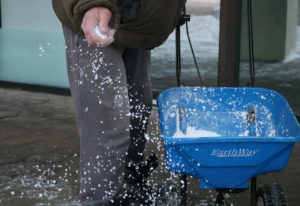The use of salt in Windsor

Photo by Ryan Percy.
The use of salt for melting ice and snow on roads, highways and sidewalks keeps people safe but is also damaging the environment.
Essex County is responsible for maintaining about 1,500 kilometres of roads. The county maintains 18 salt/plow routes. Of those trucks 13 are county vehicles – combination trucks capable of salting, plowing and winging, or pushing snow back from the road. Five trucks are brought in on contract to handle the remaining five routes.
The county used 31,527 tonnes of salt and 136,119 tonnes of brine in 2018. The county’s snow removal budget for 2019 and 2020 is $2.7 million.
Crews pre-wet the salt, which makes it work faster and at lower temperatures. They apply a salt-brine solution to the pavement ahead of snowfalls, which helps prevent snow and ice accumulation. The county informs Environment Canada each year about the amount of salt and brine used.
A GPS is used to track application of salt to ensure safety and environmental standards are met.
Heather Crewe is a resident of Essex County and recently retired from the Ontario Good Roads Association.
“Salt interferes with plants’ ability to take up moisture, most plants do not react well when they are exposed to the salt spray from road treatments,” said Crewe.
She also said geothermal heat was installed in 2012 on a bridge on County Road 23 as an alternative to salt treatments.
According to Crewe, the installation cost of geothermal heat is quite hefty and access to the heating coils for maintenance if they fail is another cost consideration.
Products like sugar beets, mash from beer, whisky and brine can be added into salt to melt the ice and snow.
Katie Stammler is a water quality scientist at the Essex Region Conservation Authority.
“Chloride concentration is a component of salt, and is increasing in watercourses across the province and the long term impact will on aquatic ecosystems is not yet known,” said Stammler. “We tend to err on the side of caution which often means over applying salt.”
She also said automatically stopping salt application when trucks are stopped is one way of reducing the amount of salt on the roads.
Additional Information
According to Heather Crewe the following advice can be used to decrease the amount of salt on roads.
- It starts by making sure that their public works department has a salt management plan. Not only will this form the framework for Operations decisions about treating the road with deicing chemicals a salt management plan is also a requirement for source water protection in Ontario’s watersheds.
- Make sure that public works operations personnel from the snowplow operator to the supervisor to the department manager are trained on the latest road salt management techniques. Ontario good roads association offers an annual 3 day snow school for Operation personnel.
- Keep salt stored in a covered building on an impermeable surface to prevent chlorides from leaching into the ground and ultimately into the water table.
- Reduce road salt use near wellheads and highly salt vulnerable locations (such as water intake protection zones).
- Pretreat roads and salt brine before a snow event. This enables plows to clear to bare pavement by preventing the bond of snow and ice to the pavement. It will also prevent the formation of frost and black ice.
- Hire a value added meteorological service (VAMS) to provide accurate weather forecasts for your specific area so that you can pretreat roads according to the type of precipitation expected, know when it will arrive and plan your operations resources according to how long the winter storm event is expected to last.
- Install or link into nearby installations of Road Weather Information System (RWIS). These are towers installed along the 400 series of provincial roads and in some of the larger municipalities such as Toronto and Ottawa. Each station monitors the temperature and chemical conditions of the pavement at that specific location, along with radar, wind, precipitation and others elements. This information allows the operations manager to know whether there is sufficient chemical on the road to prevent the pavement from freezing or if a crew needs to retreat the road at that location. This way salt usage is reduced by ensuring it is only applied when necessary.


